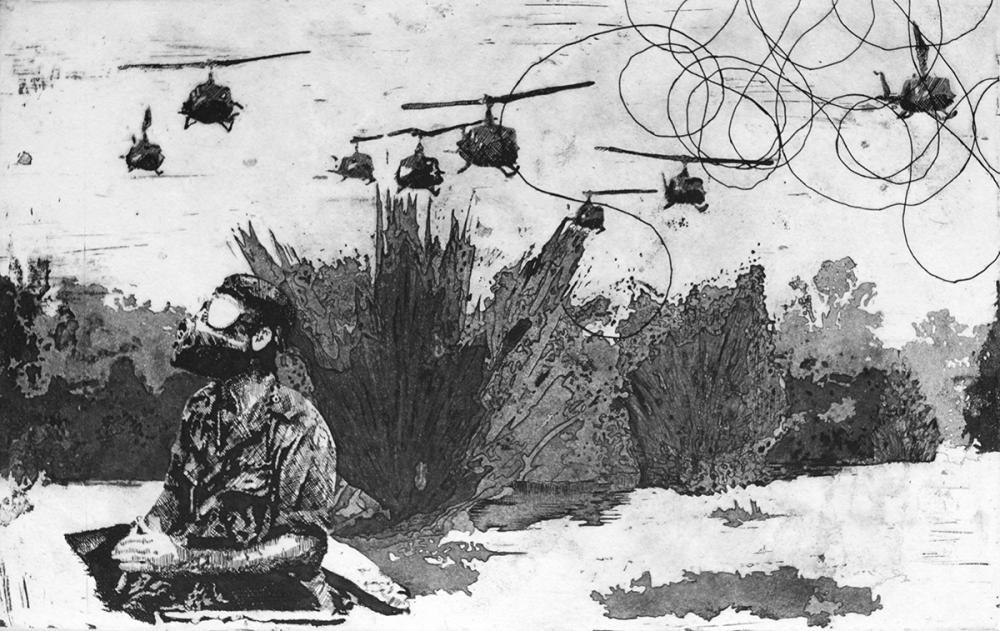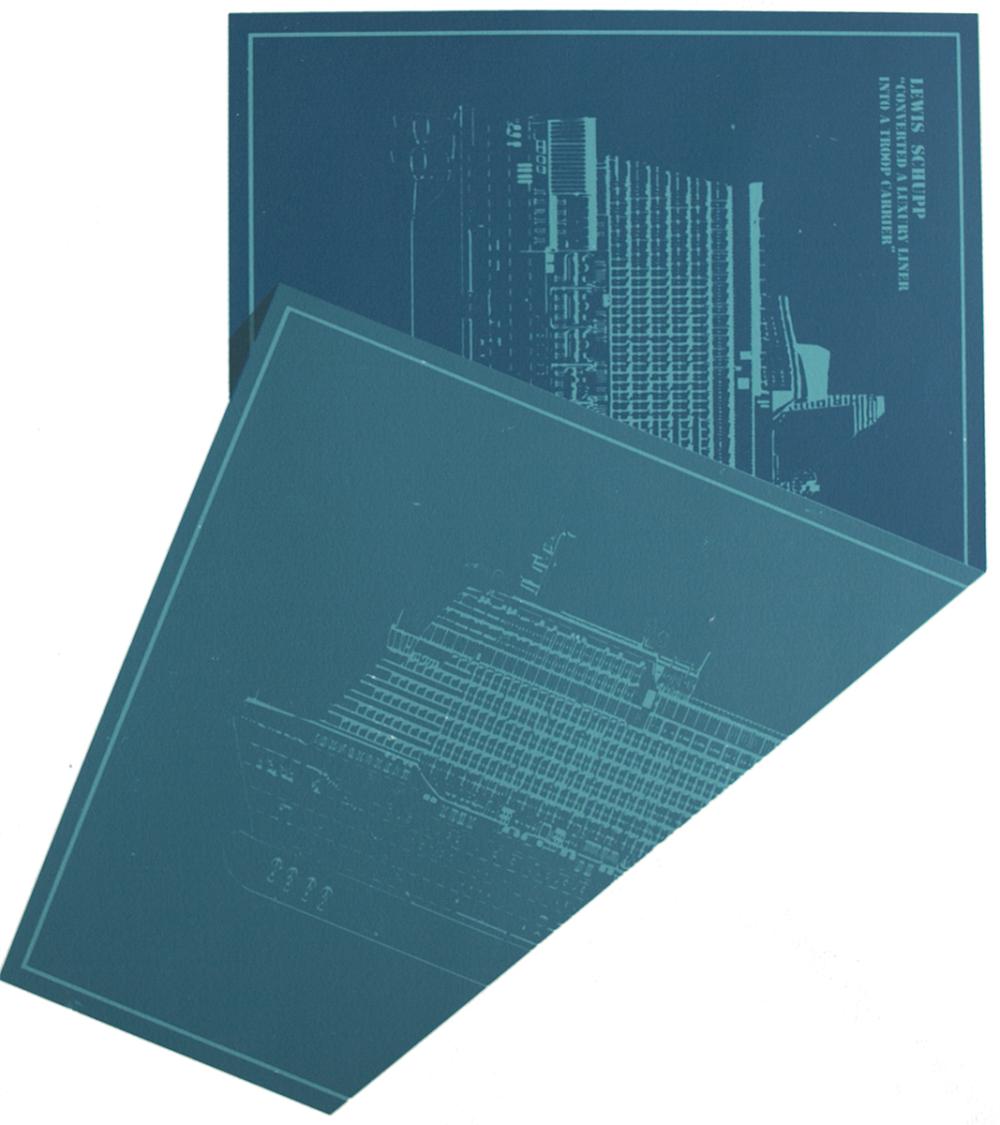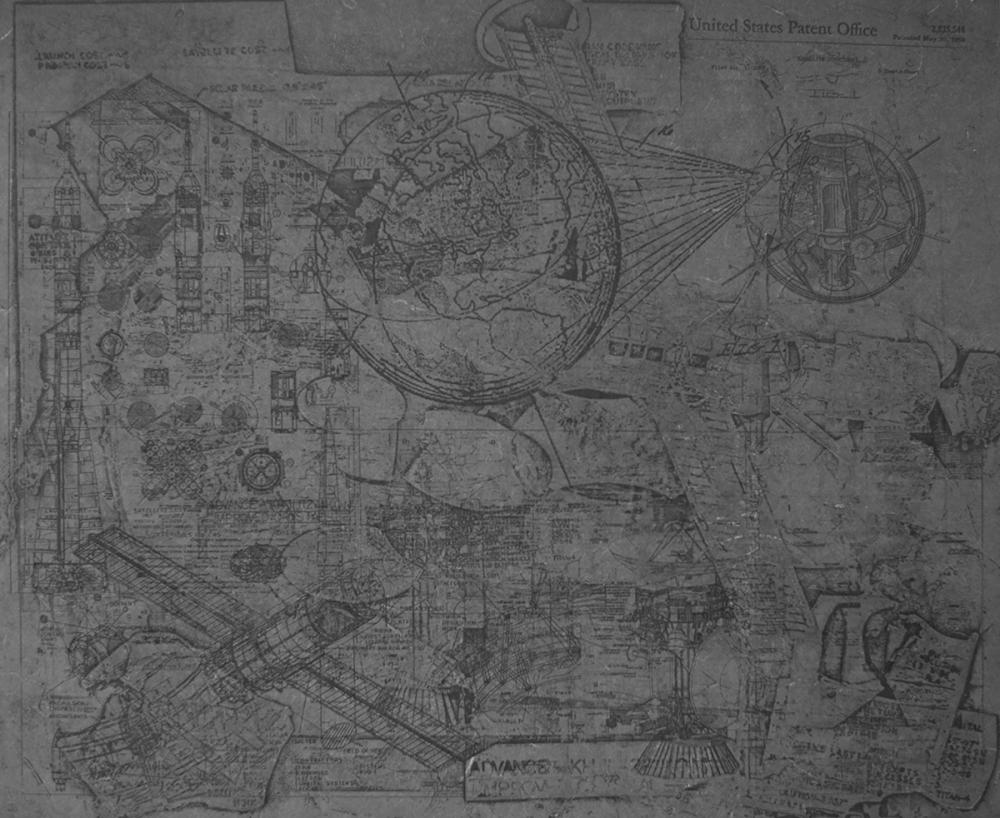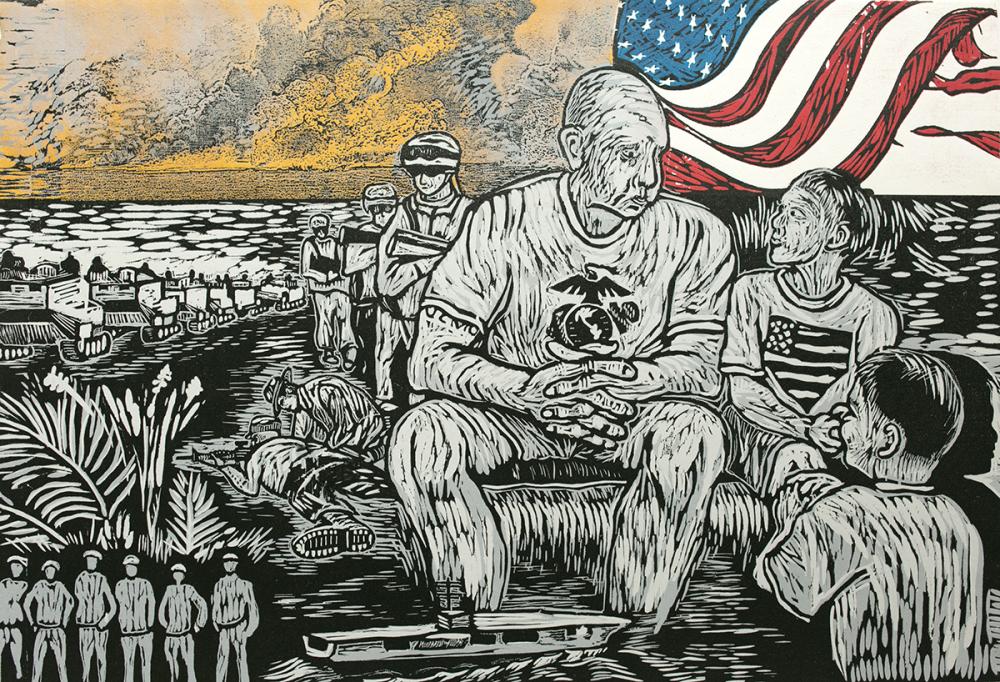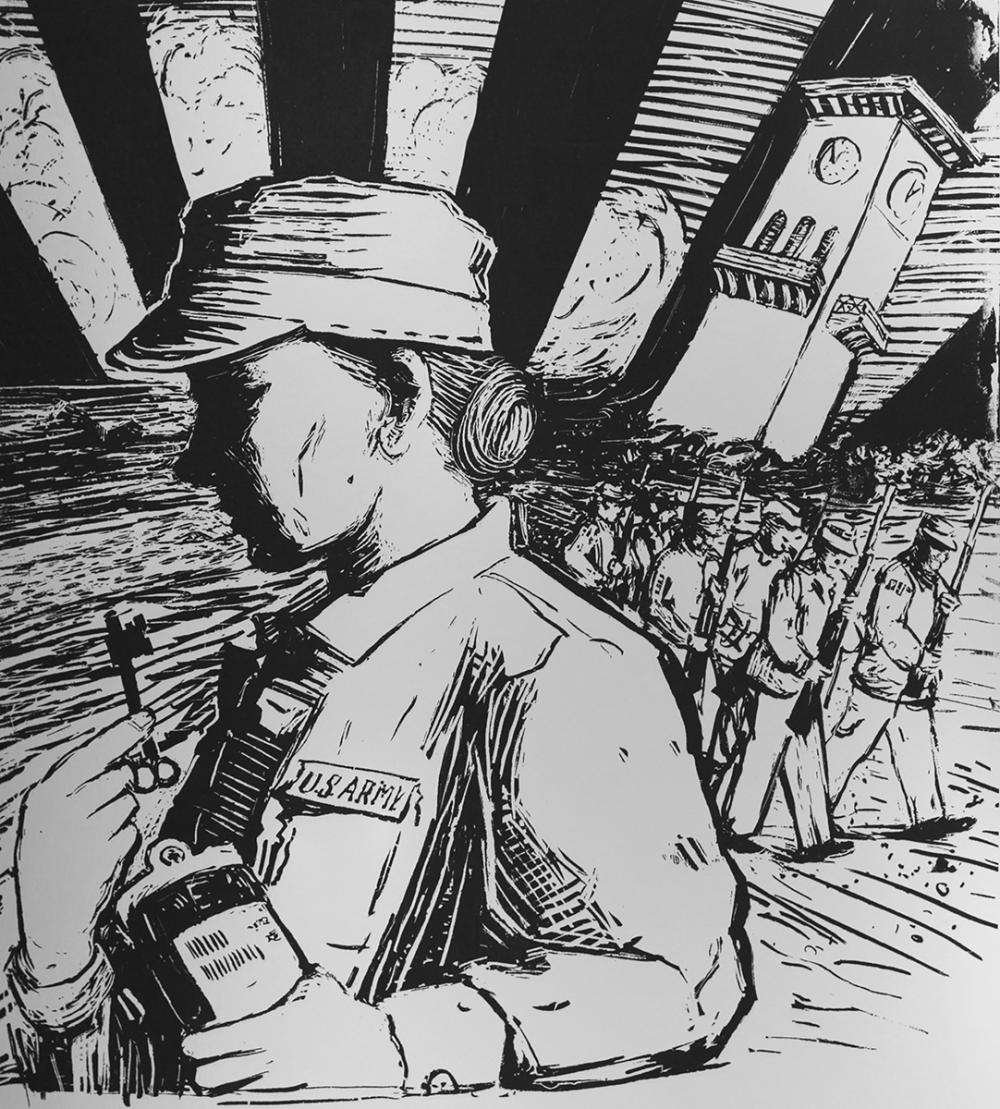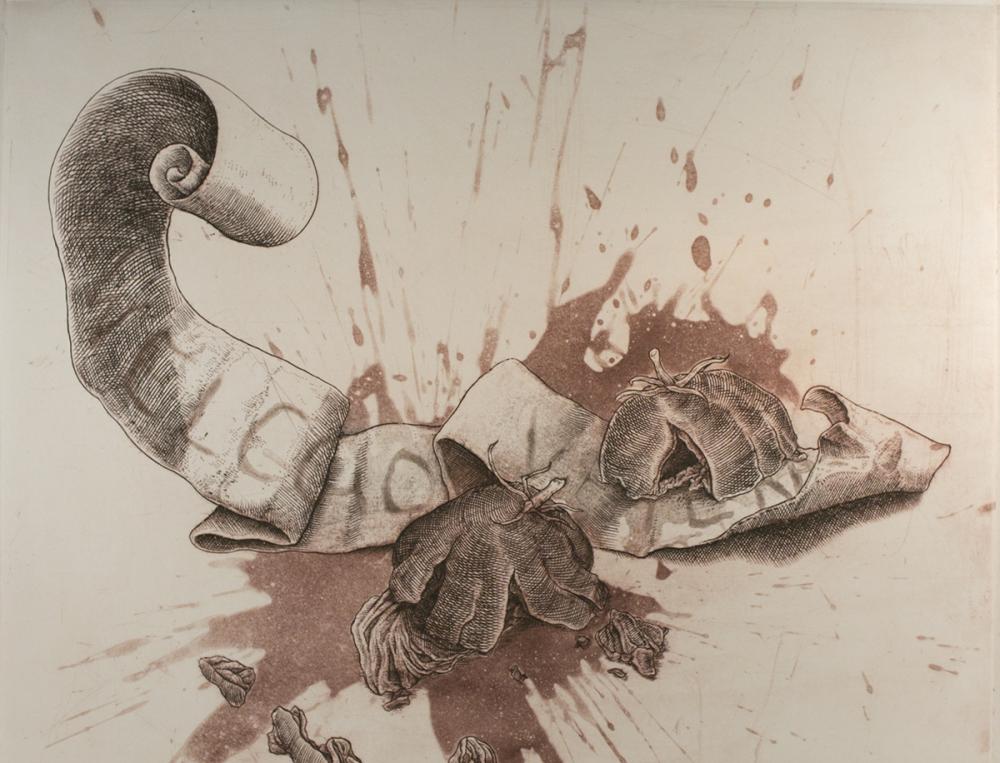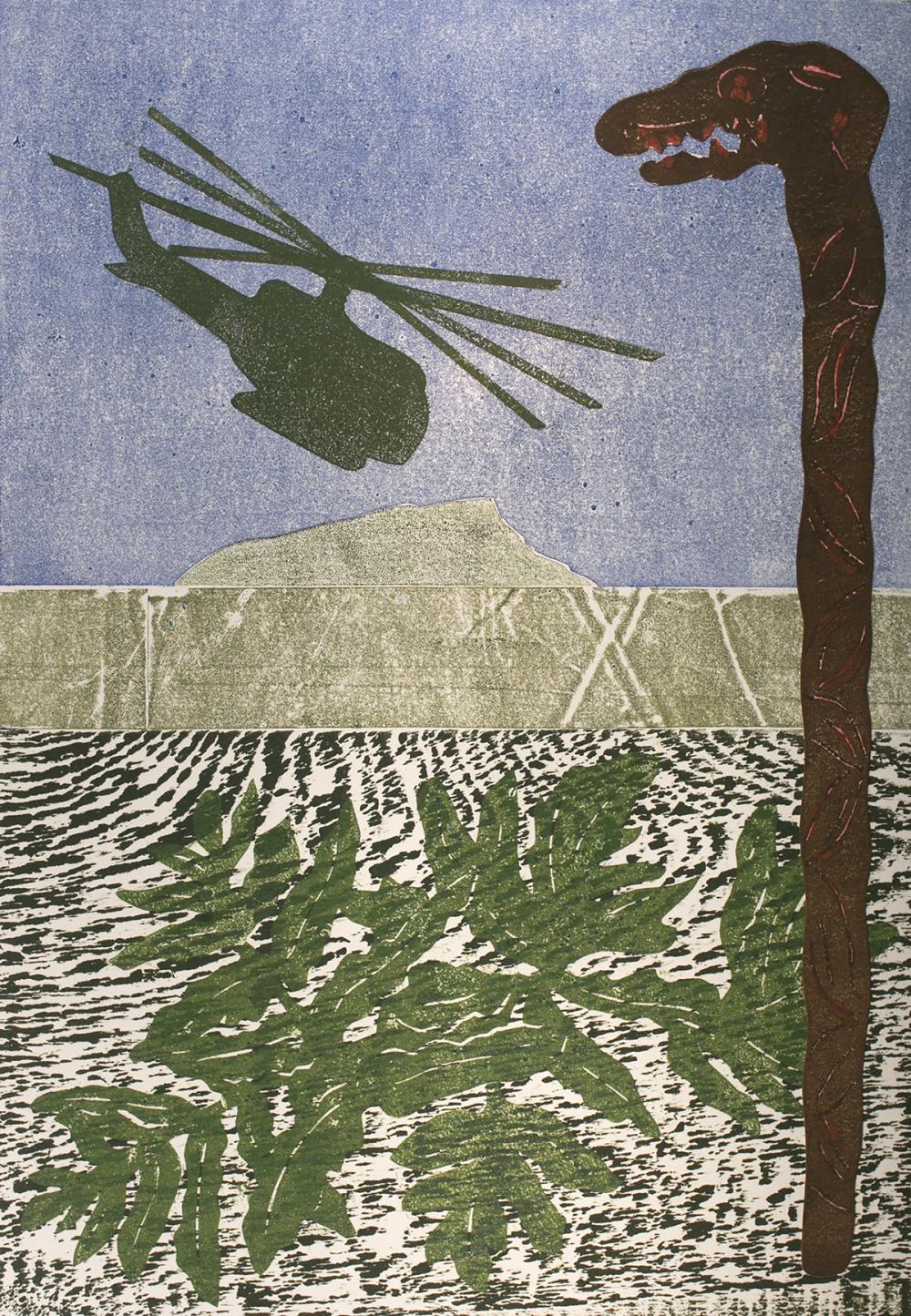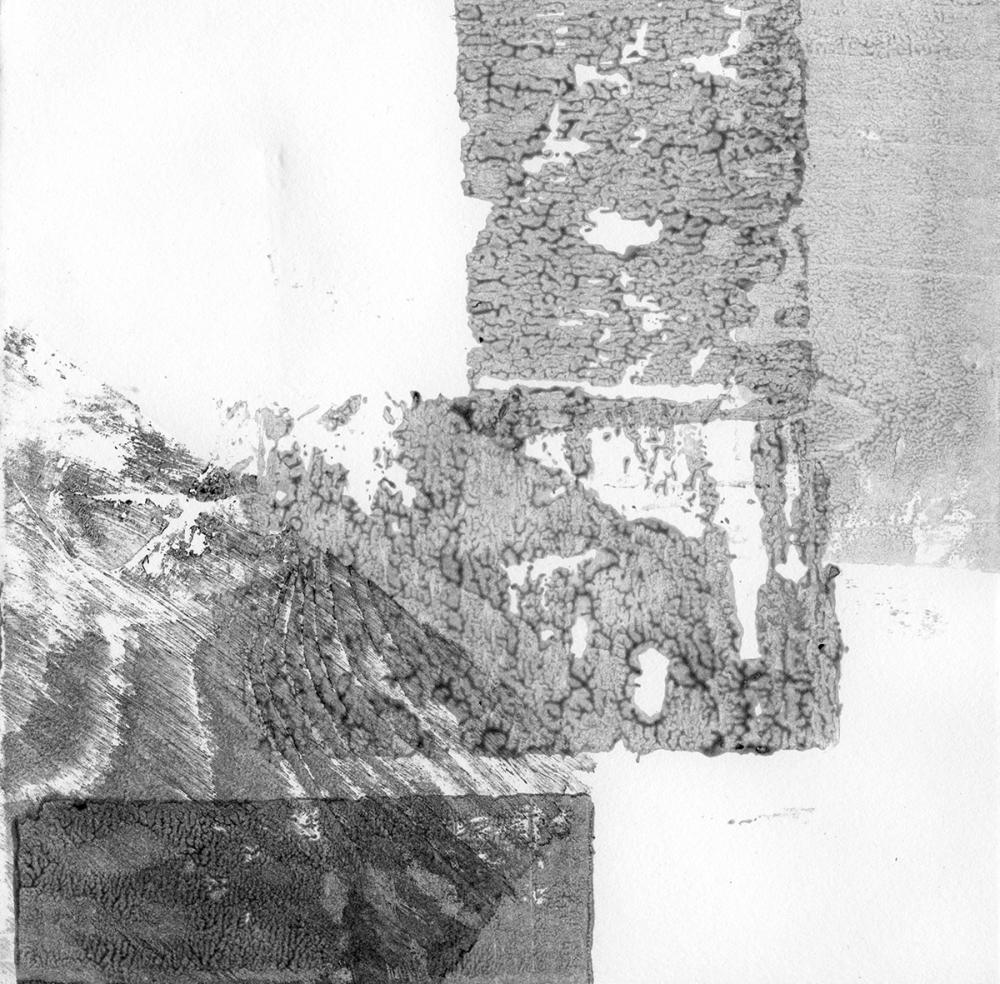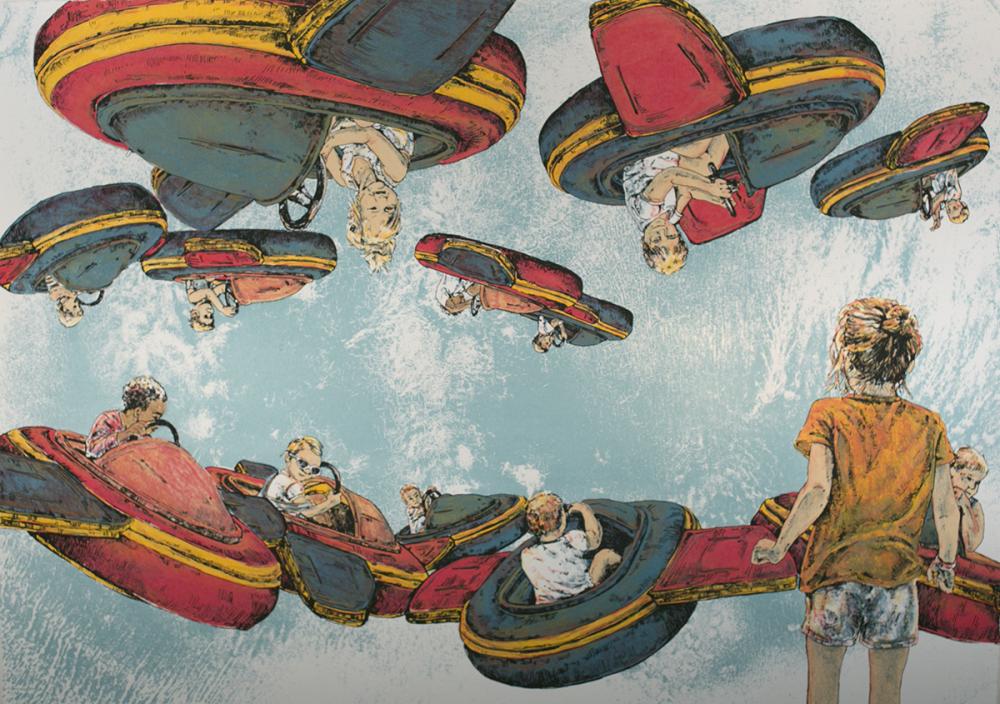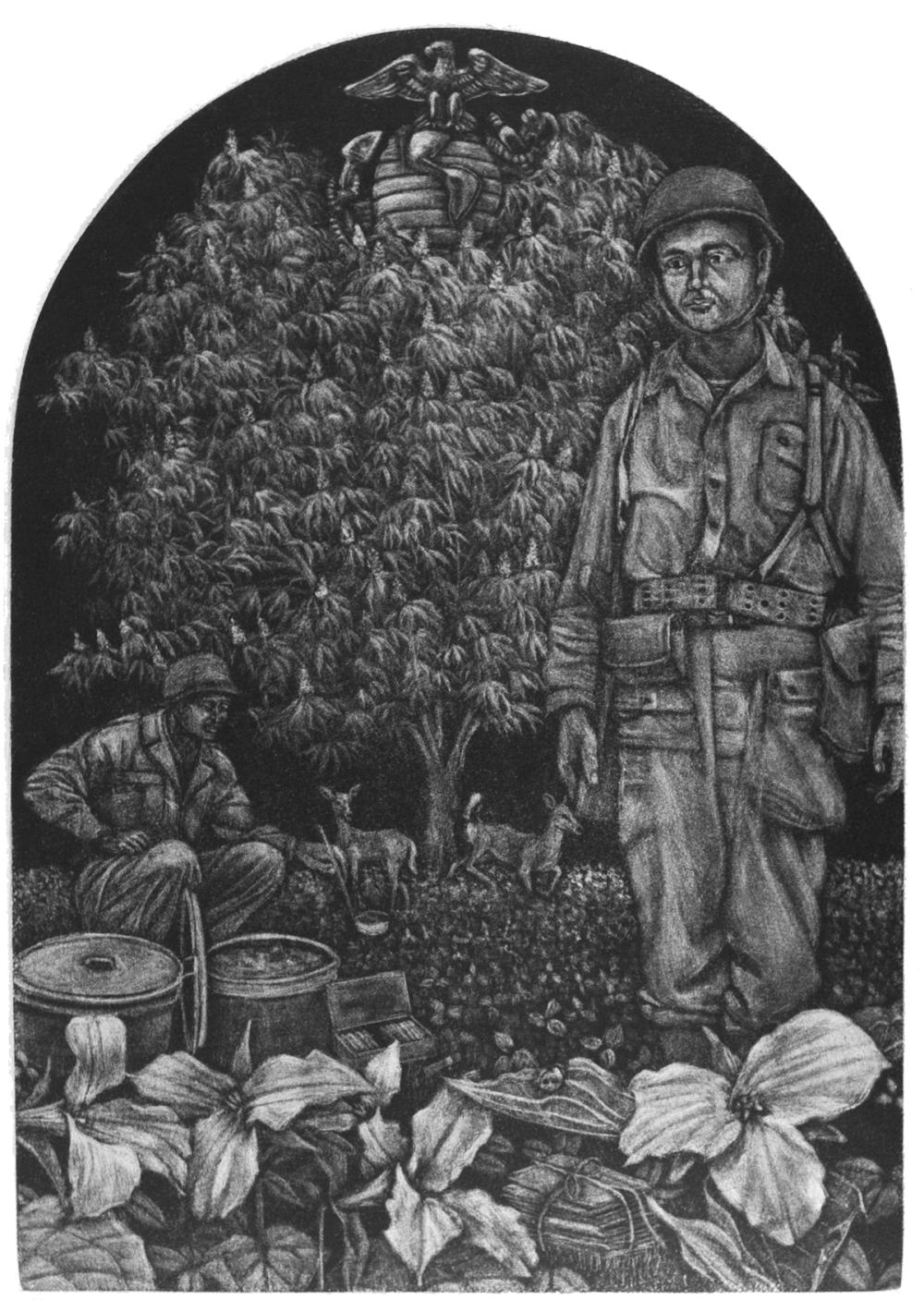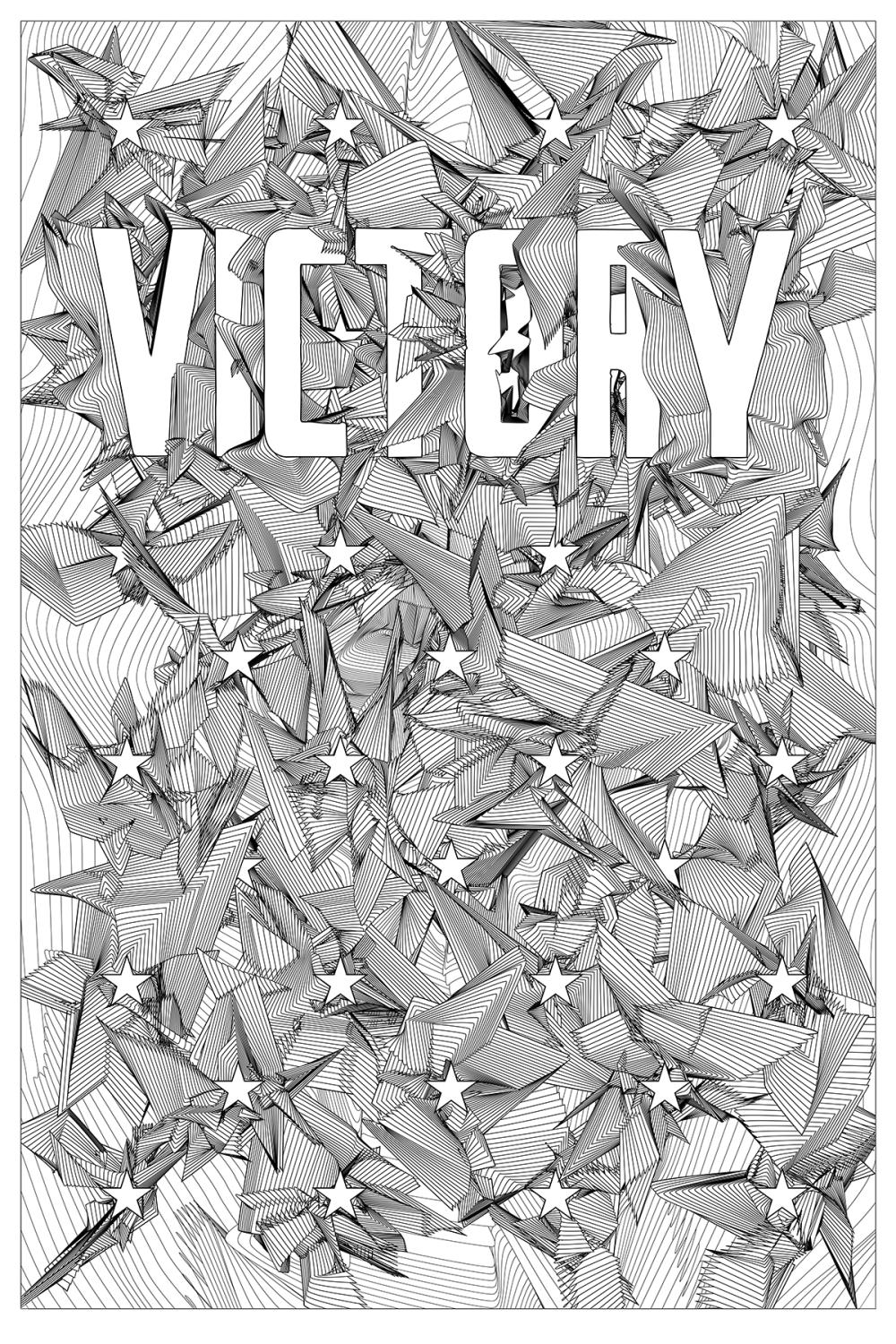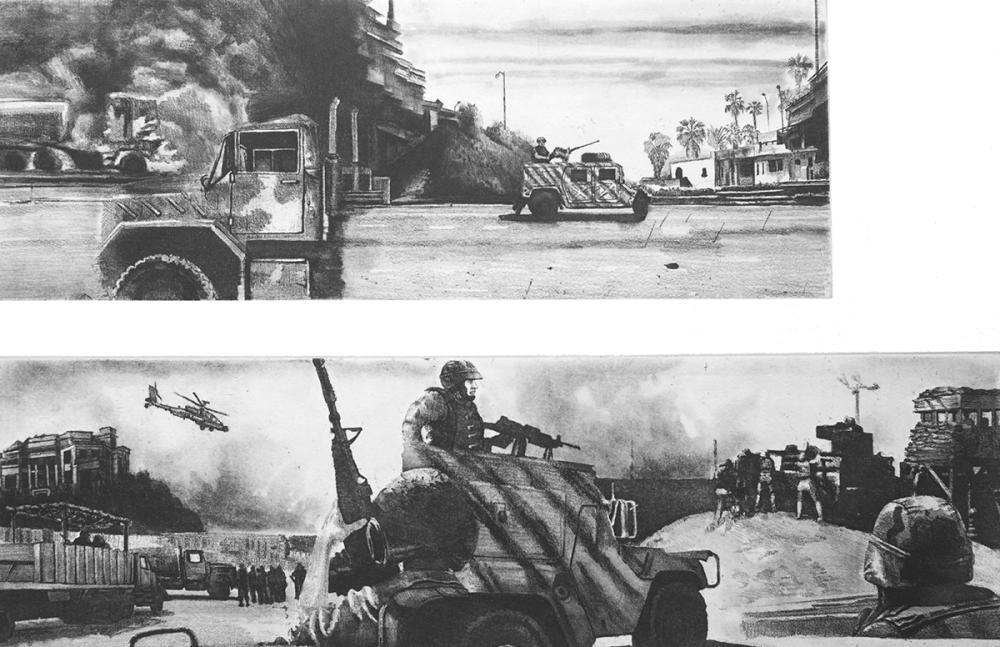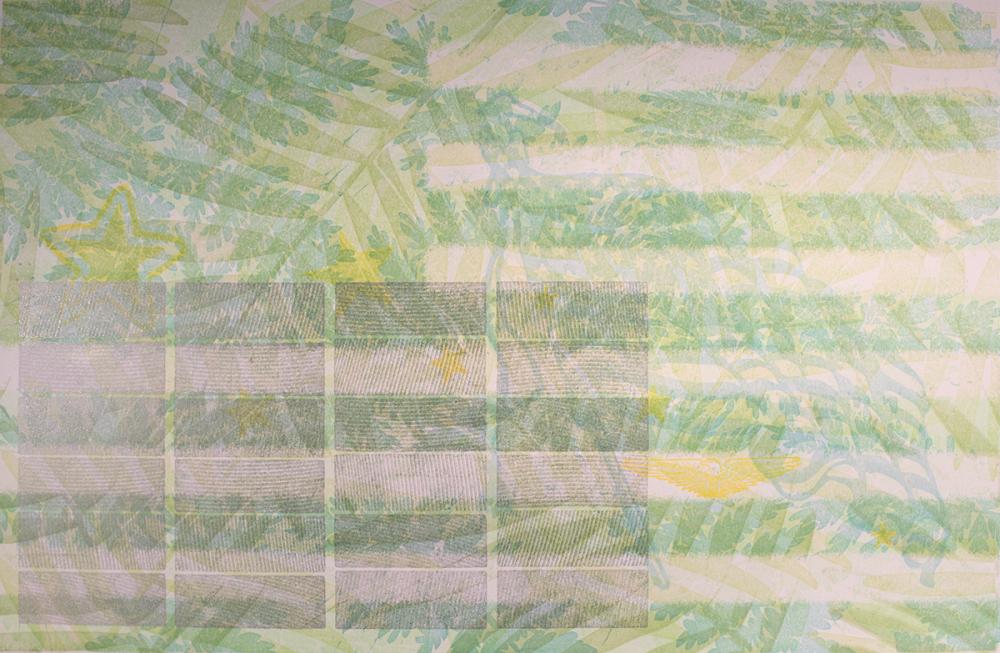EVAC
Mental health providers are losing the battle with helping veterans in part because veterans feel isolated and don’t want to ask for help. Veterans commit suicide at a rate of 20 per day (US Department of Veterans Affairs, 2016). Deployed veterans who served between 2001 and 2007 had a 41% higher suicide rate than the general population (Kang et al., 2015). Studies show veterans who share their stories may help with PTSD recovery (Bunnell et al., 2017; Erbes, Stillman, Wieling, Bera & Leskela, 2014; Hassall, 2013).
Experiencing Veterans and Artists Collaborations (EVAC) brings together veterans and artists. Veterans from all branches of the military, with service during WWII through Iraq and Afghanistan were interviewed about their experiences. These veterans and their stories were paired with artists who made an edition of prints based on their interpretation of what they heard. Excerpts from the interviews are displayed with the art. With EVAC, veterans have an opportunity to share their stories one time, and to have that story impact many people.
EVAC is about the art of interpretation. Veterans tell their life experiences as a series of stories and responses to prompted questions. Artists distill interviews from 30 minutes to 4 hours down to a single image. Viewers see the image and excerpts from the interviews side by side. Through this process of interpretation, EVAC works to combat the isolation common to veterans and to bridge the sometimes precarious gap between military and civilian life.
By providing a glimpse into a veteran’s personal experiences, EVAC creates an environment for viewers that invite understanding and engagement. Art offers a unique opportunity to foster empathy, as it uses the senses to suggest feelings, stretches the imagination and invites understanding (Peloquin, 1996). Empathy can create an emotional reasoning process to allow people to experience someone else’s reality (Degarrod, 2013). A frequently-cited 2011 analysis of 72 empathy studies of 14,000 U.S. college students since 1979 indicates there is a 48% decline in emotional empathy, or emotional concern, within our culture (as cited in Merritt, 2017). Empathy is critical to fostering a society that places value on human dignity for all (Merritt, 2017). The process of storytelling and interpretation central to EVAC makes it a project uniquely positioned to promote empathy from multiple groups – the artist and viewer for the veteran’s experience, and the veteran for the artist’s interpretation of their stories.
EVAC was on display from November 1, 2017 - January 31, 2018.
View the entire ehhibit and Veteran stories at evacproject.org
EVAC Curators
Lee Fearnside, Associate Professor of Art, is also the Director of the Diane Kidd Gallery at Tiffin University. As Gallery Director, she has curated group exhibitions around themes of sustainability, diversity, food systems and art from Ohio prisons, funded in part by grants from the Ohio Arts Council and the Ohio Humanities Council. Her photographic work has been exhibited in galleries in New England, the Midwest and in national juried shows. Fearnside earned an M.F.A in Photography from the Rhode Island School of Design, and a M.S. in Arts Administration from Drexel University.
Joseph Van Kerkhove is an Assistant Professor of Art at Tiffin University in Tiffin, OH. He holds an M.F.A. in Printmaking from Indiana University and a B.F.A. from The Columbus College of Art and Design. Joseph’s work incorporates various printmaking techniques, both traditional and experimental, that express his personal experiences. He manipulates familiar images into complex compositions that allow the viewer to reflect and relate the images to their memories and personal experiences. Joseph’s artworks have been exhibited in a variety of venues nationally and internationally. He is represented by Harris-Stanton Gallery in Cleveland and Akron.
Dr. John Schupp is Assistant Professor of Chemistry at Tiffin University. He has twenty-five years experience in the synthetic crystal industry, from 1980 to 2005, and he received four patents in 2002. Dr. Schupp started a student veteran program at Cleveland State in Fall 2006, and since 2009, he has spoken to over 1,000 campuses nationwide regarding veteran education. He helped write, pass and fund legislation for FIPSE grants in 2010 and 2014, which provided $20M in grants to over twenty campuses nationwide for veteran education. Dr. Schupp is the winner of the Zachary Fisher Humanitarian of the Year award from the Department of Defense, and his name is on a plaque in the Pentagon for this honor.
Lee Fearnside
Lee Fearnside, Associate Professor of Art, is also the Director of the Diane Kidd Gallery at Tiffin University. As Gallery Director, she has curated group exhibitions around themes of sustainability, diversity, food systems and art from Ohio prisons, funded in part by grants from the Ohio Arts Council and the Ohio Humanities Council. Her photographic work has been exhibited in galleries in New England, the Midwest and in national juried shows. Fearnside earned an M.F.A in Photography from the Rhode Island School of Design, and a M.S. in Arts Administration from Drexel University.
Veteran: Tim, Air Force, Vietnam. "We got a call from the control tower saying that an American plane from the nearby base had gone down not too far from us. We got out to the crash site, and the only thing you could see was the tail section, it actually went straight into the ground like a log."
Joseph Van Kerkhove
Joseph Van Kerkhove is an Assistant Professor of Art at Tiffin University in Tiffin, OH. He holds an M.F.A. in Printmaking from Indiana University and a B.F.A. from The Columbus College of Art and Design. Joseph’s work incorporates various printmaking techniques, both traditional and experimental, that express his personal experiences. He manipulates familiar images into complex compositions that allow the viewer to reflect and relate the images to their memories and personal experiences. Joseph’s artworks have been exhibited in a variety of venues nationally and internationally. He is represented by Harris-Stanton Gallery in Cleveland and Akron.
Veteran: Bob, Army, Vietnam. "They would hide in the tunnels, and they had trap doors leading off them. They had rooms as big as our cafeteria so they could hide a whole company of soldiers underground. It’s a swamp, it’s not like you can dig anything hard out of the ground because if you dig more than a couple of feet in Vietnam you’re going to hit water.
I was assigned to an engineering company. I went as a truck driver and when I hit a land line and blew my truck up I volunteered to work in demolitions. I had never worked in demolitions before. Well that and I didn’t want to spend time on base because of some problems I had, so that’s how I got to be in the tunnels. I got to be in the tunnels to actually blow them up."
Noel Anderson
Noel Anderson (Brooklyn, NY) is an Assistant Professor at NYU’s Art and Art Professions Department in Print Media. He holds a Bachelor of Fine Arts from Ohio Wesleyan University, a Master of Fine Arts from Indiana University in Printmaking, and a Master of Fine Arts from Yale University in Sculpture. Anderson was recently included in the Studio Museum of Harlem’s exhibition Speaking of People: Ebony, Jet, and Contemporary Art, which included an internationally published book. Represented by Tilton Gallery in NYC, Anderson exhibits his research both nationally and internationally through such venues as Art Basel Miami and the Armory Show.
Veteran: Lewis, Marine, WWII. “I remember going into the jungle to find bananas. The plane I was assigned to work on got shot down, so I had a lot of free time on my hands to explore. Lots of the guys would go off into the jungle looking, it wasn’t uncommon. I came across an area marked with red and blue wires sticking up from the ground, all over the place, and I walked straight through it. I found out later it was an active mine field, some of the mines had been removed, but not all of them. I was lucky I didn’t get blown up. And I never did find any bananas.”
Denise Bookwalter
Denise Bookwalter (Tallahassee, FL) works in a range of print media including traditional and digital processes, artist’s books, installations and dimensional prints. Her work has been exhibited in a variety of venues nationally as well as internationally. She received her BA from Northwestern University and her MFA from Indiana University in Printmaking. Denise currently lives in Tallahassee, Florida and is an Assistant Professor of Art at Florida State University where she teaches printmaking and is Area Head of the Printmaking Department. She is the director and a founding member of Florida State University’s new artists’ book press, Small Craft Advisory Press.
Veteran: Bill, Marine, WWII. "Back in those days they didn’t have all the restrictions you got now. We had to pass a swimming test that I never did, and we had to pass a rifle test that I never did. I was a good typist and stuff, but I wasn’t a very damn good rifleman.
When I went in you did what you were told. You didn’t have any say so over anything. I really thought I was being shipped out ‘cause I told my mother “I’m going to Korea or somewhere.” I didn’t know where the hell I was going, then I didn’t go anywhere - and I was right there in the 3rd Battalion, right across from the drive-in theatre, so I went to a movie every night."
Noah Breuer
Noah Breuer (Davis, CA) holds a BFA in Printmaking from the Rhode Island School of Design, and an MFA from Columbia University. He also earned a graduate research certificate in traditional woodblock printmaking and paper-making from Kyoto Seika University in Japan. Noah’s work has been included in numerous group exhibitions in galleries and museums locally and internationally. His work is in the permanent collections of the Whitney Museum of American Art, the Watson Library at the Metropolitan Museum of Art, and Brooklyn Museum of Art, as well as numerous private collections. Noah works as a Full Time Lecturer at the University of California, Davis.
Veteran: Justin, Marine, Iraq /Afghanistan. ‘“I absolutely hated you when I came here. I was a Sergeant, I was told everything bad about you, the MASS (Marine Air Support Squadron) Sergeant didn’t like you,’” and he told me that my command hated me, and he was like, ‘but I respect you.’ That meant a lot to me because I basically changed his heart and mind about me, once he got to see who the real Justin was, or who the real Corporal Anthony was, in a sense like I just have pride and I care about the people around me so, yeah, I will buck the system if it is the benefit of those around me. And he respected me for that. My last year, in a sense was actually pretty good, but I had to take two years of fighting tooth and nail basically, with command, until I felt that I wore them out; little did they know that I was worn out too.”
Chris Daniggelis
Chris Daniggelis (Columbia, MO) makes elaborate one-of-a-kind prints using shapes from a simple template, subverting both the purpose of printmaking as a way to make multiples and also the romance of the expressive artist's hand. He has exhibited his work with Aminha Robinson, has been included in exhibitions juried by Donna DeSalvo (Chief Curator of the Whitney Musuem), Helen Molesworth (Chief Curator of the ICA, in Boston). He received an international residency from the Ohio Arts Council to research in Dresden, Germany and will return in 2013 as an International Fulbright Scholar. He printed for Jonathan Hammer of Matthew Marks Gallery, NYC, for Richard Serra with Master Printer Luther Davis, of Noblet Serigraphie, NYC and printed for Dard Hunter III. Before coming to the University of Missouri he taught at Columbus College of Art & Design as an Associate Professor and at Ohio State University.
Veteran: Terry, Air Force, Iraq/Afghanistan. “The digital computers were the worst stations, at that point there were only three in the world that existed, and two were at the CIA and one was at SAC, Strategic Air Command, a big player, and back in those days they had a huge budget. We had one station that was so large it had 200 hundred people, so you didn’t get to look at the computer for long. We had one copy that was the old style roll of satellite imagery and we had light tables. We’d lay them on there and you’d look with the optics and microscope. The film was on the satellite itself and they would take it and literally drop it off the satellite down to Earth. A parachute would come out and the team out in Hawaii would go and capture that film and bring it back and ship it off to D.C., process the imagery and make copies and send it all around the world so analysts could do their exploitation.”
Maggie Denk-Leigh
Maggie Denk-Leigh (Independence, OH) is an Associate Professor and Printmaking Department Chair at the Cleveland Institute of Art. She serves as the President of the Board at the Morgan Conservatory, a hand paper-making and book arts center in Cleveland, Ohio. She received her BA from Xavier University, Cincinnati, Ohio and MFA in Printmaking from Clemson University, South Carolina. Denk-Leigh’s work has recently been exhibited at the Museum of Natural History and Culture, Knoxville, Tennessee; the Shaker Historical Museum, Shaker, Ohio; and a participant in two invitational exhibitions in 2016, Confluence: Twelve Collaborations between Paper and Print Artists, at the Morgan Conservatory, Cleveland, Ohio and Things That Fly, at Heights Arts, Cleveland Heights, Ohio.
Veteran: Dan, Marine, 1983-1994. “There's several things I learned from my time in the Corps. First one is that teamwork works, as long as everybody's committed to doing what they're doing. I would say that my service gave me a lot of valuable life lessons I needed to learn and, fortunately, I learned them without getting killed. But, I think the main thing the service taught me that I still use to this day and that I impart to my own kids and anybody that'll listen is, do your research and plan if you want to do something, don't just say, "Hell, I'm gonna climb Mount Everest." Everybody says that, but doing it is different. You gotta go climb smaller mountains first, you gotta get your equipment together, you gotta know what you're doing, you gotta talk to people who have done it before. You know, I call it the seven P's - Prior Proper Planning Prevents Pitifully Piss Poor Performance. But, that's kind of the main thing, and I have stories to tell my kids and my grandkids, you know? There are some stories I'll never tell them, just 'cause there's only three people that need to know about them - and that's the enemy, me, and my God.”
Susan Doyle
Susan Doyle (Providence, RI) is an associate professor at Rhode Island School of Design and the chairman of the Illustration Department, as well as a former critic in the RISD European Honors Program in Rome, Italy. With a BFA in Illustration, Doyle spent the first decade of her career as an award-winning art director and creative director before earning a duel MFA in Painting and Printmaking. Her studio practice currently centers on narrative oil painting and plate lithography. She has been engrossed in the study of illustration history since 2007 and teaches a survey course on the subject at RISD.
Veteran: Christy, Army, 1985-2007. "And to this day it is still a man's Army. Even when I progressed through the ranks and became a Sergeant Major - the highest enlisted rank - you still felt the differences between men and women. You always felt you had to test yourself better than a man. Physical training was one way that I always proved myself. Not that I wanted to be equal, and I'm not saying I wanted to be a Navy SEAL. That's something that never appealed to me. But it got rid of some of those people with the idea that "women shouldn't be in the service," or "women aren't as good as men." I was always dealing with that constantly - you know, like the old days when guys would call women "Sweetie" and "Honey." Sometimes you had to have a thick skin, and sometimes you had to put them in their place."
Margot Ecke
Margot Ecke (Athens, GA) is the owner of Smokey Road Press. She received her MFA from the Rhode Island School of Design and her BFA from Cornell University. She received a Professional Printing Certificate from the Tamarind Institute at the University of New Mexico and completed her training by earning her Diploma in Bookbinding at the North Bennett Street School in Boston. Margot was the Victor Hammer Fellow in the Book Arts at Wells College in Aurora, New York from 2004-2006, and has taught workshops at the Penland School of Crafts, the Atlanta Printmakers Studio, the North Bennet Street School and the Ink Shop. She was an Assistant Professor of Book Arts and Printmaking at the University of Georgia from 2006-2009. Her work is exhibited both nationally and internationally.
Gold Star Parent: Cathleen MacFarlane “I was at the computer, talking to a friend in Texas, trying to figure out why we couldn’t get him on the computer. Something’s up. We heard a knock, but I couldn’t see the front door from where I was. My husband said “Cath, you’d better come here.”
When they came in the door, my husband didn’t quite understand why the first guy came in. The second guy had the Chaplain’s Cross, and then he knew right away. This is not good because they’re sending the Chaplain.
I’ll never forget those words, “your son has been killed.””
James Ehlers
James Ehlers (Emporia, KS) was born and raised in Lake Charles, LA. He earned his MFA from the University of Florida and is currently the Don and Mary Glaser Distinguished Professor of Engraving Arts at Emporia State University in Kansas — the only school in the nation to offer a BFA in Engraving Arts. Since 2007, he has given numerous engraving workshops at various events including the Frogman’s Printmaking Workshop (South Dakota), IMPACT Printmaking Conferences (Dundee, Scotland and Bristol, England), MAPC (Minnesota), and universities around the country. He has participated in group exhibitions in Bulgaria, Canada, Denmark, Poland, Portugal, Norway, Romania, The Republic of Macedonia, Turkey, and across the United States. He is also recognized as a Master Engraver by the Firearms Engraving Guild of America.
Veteran: Lauren, Army, Vietnam. "When I got back from Vietnam, I think when all of us got back, there was a certain hollowness in the return. Now maybe I should say I came back knowing I was going to be discharged, others came back knowing they were going to another duty station, and going to that duty station provided them with a support network again. I expected a welcome. I thought that's what it was all about. When our plane landed there was a gaggle of women on the other side of the chain link fence, and I thought wow this is great, a welcome. Well it was welcome in terms of jeers, accusations of baby killer, of spitting. Being gone one month short of four years, I hadn't had any knowledge of the animis that existed against Vietnam, U.S. involvement in Vietnam, and directed at the Vietnam veterans."
Joyce Collier Fearnside
Joyce Collier Fearnside (Peterborough, NH) has taught art to university students, preschoolers, and to the blind for more than forty years. Fearnside studied with Donald Stoltenberg and Vivian Berman at DeCordova Museum, MA and with Ron Pagrasso of Santa Fe, NM. She continues to use a variety of printing presses including the hand press and the car tire. Sharing what she has learned in her own printmaking helps incite new adventures for others.
Veteran: Bill, Army, Vietnam. "There was this very small cane that a few of them carried. The thing was probably between a foot and eighteen inches long and had a little dragon's head on it. It was made of bamboo, carved very nicely and stained. A real pretty little thing. It was what they called a short timer's stick. You started carrying it around when you had less than six months to go on your tour, less time than you'd already put in. It was kind of a, you know, a badge of honor when you carried that thing around."
Holly Hey
Holly Hey (Luckey, OH) is currently an Associate Professor of film and video production within the Department of Theatre and Film at The University of Toledo. She is also the current head of the Film program. Professor Hey holds an MFA in filmmaking from the School of the Art Institute of Chicago and a BFA in photography from Ohio University. Her work has screened at professionally recognized festivals including The Aesthetica Short Film Festival – York, UK, the Ann Arbor Film Festival –Ann Arbor, Michigan, the Athens International Film and Video Festival – Athens, Ohio, the Mix Festival -New York, the Onion City Film Festival -Chicago, the Denver International Film Festival, the Vancouver Queer Film and Video Festival, among other national and international venues. In addition Professor Hey has also had her short documentary Rat Stories distributed through The National Educational Television Association (NETA).
Veteran: Robert Croom, Army, Vietnam. "My first MOS was wire work. The reason being I had worked for Ohio Bell. I listened to Morse code and typed it. Then we had to climb poles. It was a lot better than boot camp."
Yuji Hiratsuka
Yuji Hiratsuka (Corvallis, OR) was born in Osaka, Japan. He has a B.S. in Art Education from Tokyo Gakugei University, and degrees in printmaking from New Mexico State University (MA) and Indiana University (MFA). He currently is a professor of printmaking at Oregon State University. Hiratsuka has received numerous international awards. Since 2010 he has had 13 solo shows in the US, as well as in Korea, Canada and Northern Ireland. Some of the public collections that include Hiratsuka’s art are The British Museum, Tokyo Central Museum, Panstwowe Museum in Poland; The House of Humor and Satire in Bulgaria, Cincinnati Art Museum, Cleveland Art Museum, Portland Art Museum, New York Public Library, The Library of Congress and The Smithsonian’s Museum of Asian Art.
Veteran: Mitch, Army, Vietnam. “I had one of the guys go over and take a sample - scoop up all the maggots he could find. He brought the maggots back and I put them on my arms and legs. And they started eating dead tissue, which stopped the bleeding. That lasted until the evacuation helicopters came and got us - everybody that was wounded. They got put in the chopper and the medic looked at me and seen the maggots and thought I was already dead.”
Erin Holscher Almazan
Erin Holscher Almazan (Dayton, OH) is an Associate Professor of Printmaking and Drawing at the University of Dayton in Dayton, OH. Erin is a native of North Dakota. She received her BFA in Fine Arts from Minnesota State University Moorhead and her MFA in Printmaking from Rochester Institute of Technology, in Rochester, New York. She taught as an Adjunct Instructor in Foundations at Rochester Institute of Technology prior to teaching at the University of Dayton. She has completed two printmaking residencies at the Frans Masereel Centrum in Kasterlee, Belgium. Erin’s work has been exhibited nationally and internationally and has recently been included in exhibitions in connection with the Southern Graphics Printmaking Council and the Mid-America Print Council, both of which she is a member. Erin is also an active member of the Dayton art and printmaking community. She resides in Dayton with her husband and two sons.
Veteran: Edgardo, Army, Vietnam. “The war was really scaling up and so I can't tell you how many letters of condolences I had to write because I was the letter writer. You know, "Your son was blah, blah, blah. Dear Mrs." The Colonel would sign off on them. But that was my job, to write them.
I had to, like, sometimes, make up how they died because I didn't know it all at the time. I had to talk to a lot of guys to tell me exactly what went on. You had to, like, note-take everything that happened. That went on in battle and this is what happened. These guys were involved. Just in case in somebody needed a bronze star, you had to write all that stuff. So, I was, like, I was the scribe. I was the narrator for all that stuff.”
Teresa Larsen
Teresa Larsen (Odense, Denmark) has worked with printmaking for more than 6 years at Funen Printmaking workshop. The workshop has more than 300 members from more than 20 different countries. Larsen teaches photogravure at the workshop. In 2013, she received the Bodil Award (Bodil prisen) from Funen Printmaking Workshop. She is also a member of SAKs Printmaking Workshop, and Danish Printmakers. Her work is shown at The Studio Gallery in Odense, Denmark.
Veteran: James, Army, Desert Storm. "We took a team and we snuck across the border and got within a reasonable distance. He had this, I don’t even know what it was, it looked like something out of a Star Wars movie, he sets this thing up. I’m looking with my night vision goggles and as I’m looking at a little building over there you could see the guns sticking up. And then I see this red bright light and I’m thinking “what is that?” and it’s a guy smoking a cigarette."
Keith Lopez
Keith Lopez (Odense, Denmark) has a Master of Fine Arts from Rhode Island School of Design and a Bachelor of Arts from College of Charleston. He has worked and taught in different studios and schools in the United States, and currently lives in Denmark.
Veteran: Jim Roberts, Army, Vietnam. "The real advantage with being Sergeant is that you had a private little room at the end of the barracks. I remember as a present for my mother, I thought it would be nice to have an oil painting done of myself, and I had it in my room. Well one night the guys came in, and it was gone, I was off having a Coke or something. They got to my painting and hung it up in a tree, right along the row of toilets."
Kathy L. McGhee
Kathy L. McGhee (Galloway, OH) works at the Columbus College of Art and Design. There she is an associate professor in fine arts, and area coordinator of printmaking. She teaches introductory, intermediate and advanced printmaking. These include relief, serigraphy, lithography, and intaglio. McGhee, who has shown her work both nationally and internationally, is a practicing printmaker who has had her work published in Printmakers Today. McGhee received the Greater Columbus Arts Council’s International Residency Award in 2005 and traveled to Germany. In 2010, she was a participant in the Xi’an International Printmaking Workshop held at Xi’an Academy of Fine Arts in China, and in 2012, she received an international residency through the Ohio Arts Council.
Veteran: Sherri, Air Force, 1990’s. "Temporary Duty, it's kind of like you get to travel because it's almost like photojournalism. Everybody wanted to go to Thailand, you know what I mean? They wanted to see the world. So it was kind of like if you fight us, if you argue with us, or if you call us out on what we're doing, then you won't go. They pretty much said you won't go anywhere. So I got stuck in the dungeon, me and a couple of the other female sergeants that didn't play by their rules. The dungeon was the archive room where we archived all the photos and slides. Anybody who instead played their game got to travel."
Johanna Mueller
Johanna Mueller (Fort Collins, CO) is a printmaker, artist and entrepreneur, from Denver, CO, and believes firmly that she was put on this earth to make prints. She earned a BFA in printmaking from The Metropolitan University of Denver and an MFA in printmaking from George Mason University in Fairfax, VA. After her MFA, Johanna was set on becoming a full time artist, and so began traveling to sell her work at art fairs across the country, earning over 7 Best in Show awards and over 16 place awards since 2011. She has had the opportunity to speak to students about her work, the business of art, as well as demonstrate engraving methods at institutions including: Vanderbilt University, Bowling Green State University, Bethel College, Texas A&M University of Corpus Christi, and many more. In 2015, she was the recipient of the Laila Twigg Smith Artist Residency Program at the Donkey Mill Arts Center, in Kona, HI, and was an Artist in Residence at Anderson Ranch in 2010. She co-owns and operates The Lion’s Nest Gallery and Printshop in Austin, TX, while living and maintaining a personal print studio in Fort Collins, CO.
Veteran: Mike, Navy, 1990’s. "After months and months at sea and finally coming home, it’s bigger than life to see land coming in and see the base. I had no idea that all the family and stuff would be there—I mean, I guess I did — but I didn’t think about the enormity of how that event would be. All hands are on deck at parade rest and we were cruising into port. It was really neat seeing land and seeing people back at home. To see the flags waving and the band playing was a good experience, a really good experience."
Akemi Ohira
Akemi Ohira (Charlottesville, VA) specializes in intaglio, lithography and relief printmaking practices, as well as egg tempera paintings. She received a Bachelor of Fine Arts with Printmaking and Drawing Concentrations from Cornell University, and Master of Fine Arts from Carnegie Mellon University. She is a recipient of numerous awards and fellowships, including SECAC and
Professional Fellowship from the Virginia Museum of Fine Arts. Her work has been featured in solo and group exhibitions in North America, Europe, Australia and Asia. She teaches Printmaking and Drawing at the University of Virginia where she is an Associate Professor of Studio Art.
Veteran: Ken, Marine, Korea. "I was on the switch board. We had these switchboards every ten miles, they had to. I had it fixed up when that telegram came into headquarters I was to get a quick phone call. The next day I went up to the headquarters to pick up the telegram and while I was there the headquarters was calling back for me to come up because I had a telegram. The telegram said “you’re a father.” So I passed out the cigars I’d been collecting to some of the guys that I was in with. I think I sent one to the big cheese back in communication headquarters. And of course George got one, George Burns, not George Burns and Gracie, but George Burns the guy from Michigan, he was the cook."
Andrew Polk
Andrew Polk (Tucson, AZ) has a BFA from Memphis State University and an MFA from Indiana University. He teaches at the University of Arizona, School of Art. Polk’s paintings and works on paper have been exhibited throughout the United States, and internationally in Australia, India, New Zealand, Slovakia, China and Bulgaria. As an artist, Polk works in a wide range of media that includes lithography, digital imaging, painting, and drawing.
Veteran: Joe, Army, WWII. "My job was to get up in the morning, have breakfast, and go to the motor pool, and stay there until about 6 o’clock and go to sleep. That was my basic training. I did that for a period of time. From England we went to Belgium. We were going to build an airfield in a little town. We took over a tremendous cabbage patch. There was cabbage as far as the eye could see. Our job was to strip that and make runways out of it."
Michelle Rozic
Michelle Rozic (Northridge, CA) is an Associate Professor of Art, Printmaking Coordinator and Graduate Coordinator at California State University, Northridge, with an MFA in printmaking from Indiana University, Bloomington, and BFA in fine art from the Columbus College of Art & Design. She served as president of the Los Angeles Printmaking Society from 2013–2015. Michelle’s work is held in national and international collections, and her work has been featured in over one hundred national, international and traveling exhibitions. Projects include curating Edge of Life: Forest Pathology Art, a collaborative, invitational, art and forestry exhibit and accompanying catalog.
Veteran: James, Army, Iraq/Afghanistan. “At that point they were starting to concentrate their fire on the wall, right where we were at, and they were hitting it with RPGs. You’d be sitting there and all of a sudden cinder blocks would fly everywhere. We’ve got small arms fire going out and small arms fire coming in, I’m on the radio trying to get some soldiers up here to defend this perimeter. And nobody was coming. People were taking cover because there was so much fire coming in. These guys had launched this Hellfire on this one area. So for the first five or ten minutes we’re the only ones there and we’re pushing them back. Once again we’re at the apex.”
Sydney Webb
Sydney Webb (Kaufman, TX) graduated with a BFA in printmaking from Herron School of Art and Design in 2010. After earning her BFA she opened Wake Press & Gallery, her first endeavor at a custom print shop. During this time, she worked as a studio assistant to Walter Knabe. Returning to academia, Syd earned her MFA degree from the University of Texas Arlington in 2014. In 2012 she interned at the infamous Hatch Show Print in Nashville, TN. It was this experience that became the catalyst for Syd’s role in the entrepreneurial endeavor Wild Pony Editions on the UTA campus. Syd's shop 4 ACRE PRESS is her private letterpress studio in Kaufman, TX. She is currently Interim Printmaking Area Coordinator at the University of North Texas.
Veteran: Thomas, Marine, Vietnam. "The other two guys had been shot as well, and one guy over here he ain’t there anymore, I don’t know where he went. I never saw him again. I pushed myself off and landed on my face and the other two guys had just rolled off or fallen off - whatever - they were on the ground. One had crawled around to the front and tried to crawl underneath the track. The other one was just laying there. I don’t even know what their names were, just the other two new guys."

